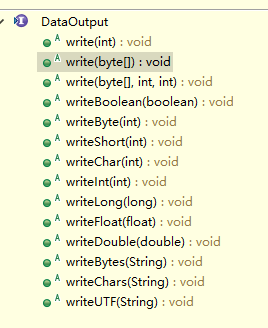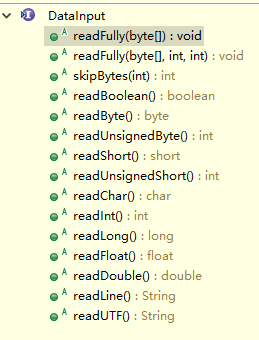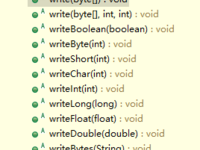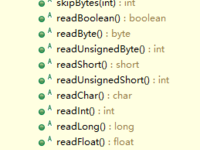Java Socket编程实例:http://donald-draper.iteye.com/blog/2356695
java Socket读写缓存区Writer和Reader:http://donald-draper.iteye.com/blog/2356885
Java NIO ByteBuffer详解:http://donald-draper.iteye.com/blog/2357084
Java
序列化与反序列化教程:http://donald-draper.iteye.com/blog/2357515
在上面一篇Java序列化与反序列化教程,我们通过实例,分析了Java序列化与反序列化,今天我们来更深入的去看一下ObjectOutputStream和ObjectInputStream是如何序列化与反序列化对象和原始类型的;
1.序列化
class="java">ObjectOutputStream objectOutputStream = null;
try {
objectOutputStream = new ObjectOutputStream(outFile);
} catch (IOException e) {
e.printStackTrace();
}
PersonX person = new PersonX("donald", 27, "man");
try {
objectOutputStream.writeObject(person);
objectOutputStream.writeInt(4);
objectOutputStream.writeUTF("it is a man");
objectOutputStream.close();
} catch (IOException e) {
e.printStackTrace();
}
序列化的关键在这几句
objectOutputStream = new ObjectOutputStream(outFile);
objectOutputStream.writeObject(person);
objectOutputStream.writeInt(4);
objectOutputStream.writeUTF("it is a man");
我们一句一句的分析,先看构造ObjectOutputStream
public class ObjectOutputStream
extends OutputStream implements ObjectOutput, ObjectStreamConstants
{
/** filter stream for handling block data conversion */
private final BlockDataOutputStream bout;//对象数据输出流
/** stream protocol version */
private int protocol = PROTOCOL_VERSION_2;
** buffer for writing primitive field values */
private byte[] primVals;
/** if true, invoke writeObjectOverride() instead of writeObject() */
private final boolean enableOverride;
}
先看构造
public ObjectOutputStream(OutputStream out) throws IOException {
verifySubclass();
//关键是这个,构建对象数据流
bout = new BlockDataOutputStream(out);
handles = new HandleTable(10, (float) 3.00);
subs = new ReplaceTable(10, (float) 3.00);
enableOverride = false;
//写流头部
writeStreamHeader();
bout.setBlockDataMode(true);
if (extendedDebugInfo) {
debugInfoStack = new DebugTraceInfoStack();
} else {
debugInfoStack = null;
}
}
/**
* The writeStreamHeader method is provided so subclasses can append or
* prepend their own header to the stream. It writes the magic number and
* version to the stream.
*写流版本号和流魔数
* @throws IOException if I/O errors occur while writing to the underlying
* stream
*/
protected void writeStreamHeader() throws IOException {
bout.writeShort(STREAM_MAGIC);
bout.writeShort(STREAM_VERSION);
}
再来一下BlockDataOutputStream,BlockDataOutputStream为ObjectOutputStream的静态内部类
private static class BlockDataOutputStream
extends OutputStream implements DataOutput
{
/** maximum data block length */
private static final int MAX_BLOCK_SIZE = 1024;
/** maximum data block header length */
private static final int MAX_HEADER_SIZE = 5;
/** (tunable) length of char buffer (for writing strings) */
private static final int CHAR_BUF_SIZE = 256;
/** buffer for writing general/block data ,存放对象序列化数据*/
private final byte[] buf = new byte[MAX_BLOCK_SIZE];
/** buffer for writing block data headers,存放数据头部 */
private final byte[] hbuf = new byte[MAX_HEADER_SIZE];
/** char buffer for fast string writes ,这个用于直接写原始类型*/
private final char[] cbuf = new char[CHAR_BUF_SIZE];
/** block data mode */
private boolean blkmode = false;
/** current offset into buf */
private int pos = 0;
/** underlying output stream */
private final OutputStream out;
/** loopback stream (for data writes that span data blocks),写原始数据的输出流 */
private final DataOutputStream dout;
/**
* Creates new BlockDataOutputStream on top of given underlying stream.
* Block data mode is turned off by default.
*/
BlockDataOutputStream(OutputStream out) {
this.out = out;
dout = new DataOutputStream(this);
}
再看DataOutputStream
//DataOutputStream(DataOutput),主要用于写原始类型数据,int,float,String,double等
public class DataOutputStream extends FilterOutputStream implements DataOutput {
/**
* The number of bytes written to the data output stream so far.
* If this counter overflows, it will be wrapped to Integer.MAX_VALUE.
*/
protected int written;
/**
* bytearr is initialized on demand by writeUTF
*/
private byte[] bytearr = null;
/**
* Creates a new data output stream to write data to the specified
* underlying output stream. The counter <code>written</code> is
* set to zero.
*
* @param out the underlying output stream, to be saved for later
* use.
* @see java.io.FilterOutputStream#out
*/
public DataOutputStream(OutputStream out) {
super(out);
}
从上面可以看出,ObjectOutputStream的构造,主要是构造对象,对象输出流BlockDataOutputStream,BlockDataOutputStream主要是写序列化的流数据,BlockDataOutputStream中有一个存放序列化数据
的缓存区,头部数据缓冲区,原始类型数据缓冲区,其中关联一个原始类型输出流DataOutputStream,(DataOutput)主要用于写原始类型数据,int,float,String,double等;同时写流版本号和流魔数。
现在来看一下如何对象序列化:
public final void writeObject(Object obj) throws IOException {
...
try {
//委托给writeObject0
writeObject0(obj, false);
}
...
}
//序列化对象
private void writeObject0(Object obj, boolean unshared)
throws IOException
{
try {
// handle previously written and non-replaceable objects
int h;
if ((obj = subs.lookup(obj)) == null) {
writeNull();
return;
} else if (!unshared && (h = handles.lookup(obj)) != -1) {
writeHandle(h);
return;
} else if (obj instanceof Class) {
//如果是Class对象,则调用writeClass
writeClass((Class) obj, unshared);
return;
} else if (obj instanceof ObjectStreamClass) {
//如果是对象序列化流类型writeClassDesc
writeClassDesc((ObjectStreamClass) obj, unshared);
return;
}
...
// remaining cases
if (obj instanceof String) {
//如果对象为String直接调用writeString
writeString((String) obj, unshared);
} else if (cl.isArray()) {
//Array
writeArray(obj, desc, unshared);
} else if (obj instanceof Enum) {
//枚举
writeEnum((Enum) obj, desc, unshared);
} else if (obj instanceof Serializable) {
//序列化兑现跟这个是关键
writeOrdinaryObject(obj, desc, unshared);
}
....
}
//如果是Class对象,则调用writeClass
writeClass((Class) obj, unshared);
//序列化对象类型
private void writeClass(Class cl, boolean unshared) throws IOException {
bout.writeByte(TC_CLASS);
//写流对象
writeClassDesc(ObjectStreamClass.lookup(cl, true), false);
handles.assign(unshared ? null : cl);
}
来看这一句:
ObjectStreamClass.lookup(cl, true)
先看一下ObjectStreamClass对象
public class ObjectStreamClass implements Serializable {
/** serialPersistentFields value indicating no serializable fields */
//序列化对象属相描述
public static final ObjectStreamField[] NO_FIELDS =
new ObjectStreamField[0];
/** reflection factory for obtaining serialization constructors */
private static final ReflectionFactory reflFactory =
AccessController.doPrivileged(
new ReflectionFactory.GetReflectionFactoryAction());
private static class Caches {
/** cache mapping local classes -> descriptors,类描述缓存 */
static final ConcurrentMap<WeakClassKey,Reference<?>> localDescs =
new ConcurrentHashMap<>();
/** cache mapping field group/local desc pairs -> field reflectors */
static final ConcurrentMap<FieldReflectorKey,Reference<?>> reflectors =
new ConcurrentHashMap<>();
/** queue for WeakReferences to local classes */
private static final ReferenceQueue<Class<?>> localDescsQueue =
new ReferenceQueue<>();
/** queue for WeakReferences to field reflectors keys */
private static final ReferenceQueue<Class<?>> reflectorsQueue =
new ReferenceQueue<>();
}
/** class associated with this descriptor (if any) */
private Class<?> cl;
/** name of class represented by this descriptor */
private String name;
/** serialVersionUID of represented class (null if not computed yet) */
private volatile Long suid;
/** true if represents dynamic proxy class */
private boolean isProxy;
/** true if represents enum type */
private boolean isEnum;
/** true if represented class implements Serializable */
private boolean serializable;
/** true if represented class implements Externalizable */
private boolean externalizable;
/** true if desc has data written by class-defined writeObject method */
private boolean hasWriteObjectData;
/** exception (if any) thrown while attempting to resolve class */
private ClassNotFoundException resolveEx;
/** exception (if any) to throw if non-enum deserialization attempted */
private ExceptionInfo deserializeEx;
/** exception (if any) to throw if non-enum serialization attempted */
private ExceptionInfo serializeEx;
/** exception (if any) to throw if default serialization attempted */
private ExceptionInfo defaultSerializeEx;
/** serializable fields */
private ObjectStreamField[] fields;
/** aggregate marshalled size of primitive fields */
private int primDataSize;
/** number of non-primitive fields */
private int numObjFields;
/** reflector for setting/getting serializable field values */
private FieldReflector fieldRefl;
/** data layout of serialized objects described by this class desc */
private volatile ClassDataSlot[] dataLayout;
/** serialization-appropriate constructor, or null if none */
private Constructor cons;
/** class-defined writeObject method, or null if none */
private Method writeObjectMethod;
/** class-defined readObject method, or null if none */
private Method readObjectMethod;
/** class-defined readObjectNoData method, or null if none */
private Method readObjectNoDataMethod;
/** class-defined writeReplace method, or null if none */
private Method writeReplaceMethod;
/** class-defined readResolve method, or null if none */
private Method readResolveMethod;
}
回到这一句:
ObjectStreamClass.lookup(cl, true)
static ObjectStreamClass lookup(Class<?> cl, boolean all) {
if (!(all || Serializable.class.isAssignableFrom(cl))) {
return null;
}
//从缓存中获取对象流描述
processQueue(Caches.localDescsQueue, Caches.localDescs);
WeakClassKey key = new WeakClassKey(cl, Caches.localDescsQueue);
Reference<?> ref = Caches.localDescs.get(key);
...
if (entry == null) {
try {
//没有则,创建一个流对象
entry = new ObjectStreamClass(cl);
} catch (Throwable th) {
entry = th;
}
if (future.set(entry)) {
Caches.localDescs.put(key, new SoftReference<Object>(entry));
} else {
// nested lookup call already set future
entry = future.get();
}
}
if (entry instanceof ObjectStreamClass) {
return (ObjectStreamClass) entry;
} else if (entry instanceof RuntimeException) {
throw (RuntimeException) entry;
} else if (entry instanceof Error) {
throw (Error) entry;
} else {
throw new InternalError("unexpected entry: " + entry);
}
}
回到
//序列化对象类型
private void writeClass(Class cl, boolean unshared) throws IOException {
bout.writeByte(TC_CLASS);
//写流对象
writeClassDesc(ObjectStreamClass.lookup(cl, true), false);
handles.assign(unshared ? null : cl);
}
的这一句
//写流对象
writeClassDesc(ObjectStreamClass.lookup(cl, true), false);
private void writeClassDesc(ObjectStreamClass desc, boolean unshared)
throws IOException
{
int handle;
if (desc == null) {
writeNull();
} else if (!unshared && (handle = handles.lookup(desc)) != -1) {
writeHandle(handle);
} else if (desc.isProxy()) {
writeProxyDesc(desc, unshared);
} else {
//写非代理对象描述
writeNonProxyDesc(desc, unshared);
}
}
//写非代理对象描述
/* Writes class descriptor representing a standard (i.e., not a dynamic
* proxy) class to stream.
*/
private void writeNonProxyDesc(ObjectStreamClass desc, boolean unshared)
throws IOException
{
bout.writeByte(TC_CLASSDESC);
handles.assign(unshared ? null : desc);
if (protocol == PROTOCOL_VERSION_1) {
// do not invoke class descriptor write hook with old protocol
desc.writeNonProxy(this);
} else {
//从前面可以看出,协议版本为PROTOCOL_VERSION_2
writeClassDescriptor(desc);
}
Class cl = desc.forClass();
bout.setBlockDataMode(true);
annotateClass(cl);
bout.setBlockDataMode(false);
bout.writeByte(TC_ENDBLOCKDATA);
//写父类的类描述
writeClassDesc(desc.getSuperDesc(), false);
}
protected void writeClassDescriptor(ObjectStreamClass desc)
throws IOException
{
//委托给writeNonProxy
desc.writeNonProxy(this);
}
//ObjectStreamClass
void writeNonProxy(ObjectOutputStream out) throws IOException {
//写类名
out.writeUTF(name);
//写序列版本号
out.writeLong(getSerialVersionUID());
byte flags = 0;
if (externalizable) {
flags |= ObjectStreamConstants.SC_EXTERNALIZABLE;
int protocol = out.getProtocolVersion();
if (protocol != ObjectStreamConstants.PROTOCOL_VERSION_1) {
flags |= ObjectStreamConstants.SC_BLOCK_DATA;
}
} else if (serializable) {
flags |= ObjectStreamConstants.SC_SERIALIZABLE;
}
if (hasWriteObjectData) {
flags |= ObjectStreamConstants.SC_WRITE_METHOD;
}
if (isEnum) {
flags |= ObjectStreamConstants.SC_ENUM;
}
//写类型
out.writeByte(flags);
//写属性个数
out.writeShort(fields.length);
//遍历属性
for (int i = 0; i < fields.length; i++) {
ObjectStreamField f = fields[i];
//写属性类型
out.writeByte(f.getTypeCode());
//写属性名
out.writeUTF(f.getName());
if (!f.isPrimitive()) {
//如果是原始类型,写原始类型的字符串
out.writeTypeString(f.getTypeString());
}
}
}
//ObjectStreamField
public class ObjectStreamField
implements Comparable<Object>
{
/** field name */
private final String name;
/** canonical JVM signature of field type */
private final String signature;
/** field type (Object.class if unknown non-primitive type) */
private final Class<?> type;
/** whether or not to (de)serialize field values as unshared */
private final boolean unshared;
/** corresponding reflective field object, if any */
private final Field field;
/** offset of field value in enclosing field group */
private int offset = 0;
}
到这类写流对象描述完毕,主要写类名,序列版本号,类型,属性个数,属性描述;
回到写对象属性值;
//序列化兑现跟这个是关键
writeOrdinaryObject(obj, desc, unshared);
//写对象属性值
private void writeOrdinaryObject(Object obj,
ObjectStreamClass desc,
boolean unshared)
throws IOException
{
if (extendedDebugInfo) {
debugInfoStack.push(
(depth == 1 ? "root " : "") + "object (class \"" +
obj.getClass().getName() + "\", " + obj.toString() + ")");
}
try {
desc.checkSerialize();
bout.writeByte(TC_OBJECT);
writeClassDesc(desc, false);
handles.assign(unshared ? null : obj);
if (desc.isExternalizable() && !desc.isProxy()) {
//如果是Externalizable接口则,调用writeExternalData
writeExternalData((Externalizable) obj);
} else {
//如果是Serializable接口则,调用writeSerialData
writeSerialData(obj, desc);
}
} finally {
if (extendedDebugInfo) {
debugInfoStack.pop();
}
}
}
分两步
//如果是Externalizable接口则,调用writeExternalData
writeExternalData((Externalizable) obj);
//如果是Serializable接口则,调用writeSerialData
writeSerialData(obj, desc);
先看
//如果是Serializable接口则,调用writeSerialData
writeSerialData(obj, desc);
private void writeSerialData(Object obj, ObjectStreamClass desc)
throws IOException
{
ObjectStreamClass.ClassDataSlot[] slots = desc.getClassDataLayout();
for (int i = 0; i < slots.length; i++) {
ObjectStreamClass slotDesc = slots[i].desc;
if (slotDesc.hasWriteObjectMethod()) {
PutFieldImpl oldPut = curPut;
curPut = null;
SerialCallbackContext oldContext = curContext;
if (extendedDebugInfo) {
debugInfoStack.push(
"custom writeObject data (class \"" +
slotDesc.getName() + "\")");
}
try {
curContext = new SerialCallbackContext(obj, slotDesc);
bout.setBlockDataMode(true);
//如果对象实现了WriteObject方法,则调用WriteObject方法
slotDesc.invokeWriteObject(obj, this);
bout.setBlockDataMode(false);
bout.writeByte(TC_ENDBLOCKDATA);
} finally {
curContext.setUsed();
curContext = oldContext;
if (extendedDebugInfo) {
debugInfoStack.pop();
}
}
curPut = oldPut;
} else {
//否则,写Field
defaultWriteFields(obj, slotDesc);
}
}
}
//否则,写Field
defaultWriteFields(obj, slotDesc);
private void defaultWriteFields(Object obj, ObjectStreamClass desc)
throws IOException
{
// REMIND: perform conservative isInstance check here?
desc.checkDefaultSerialize();
int primDataSize = desc.getPrimDataSize();
if (primVals == null || primVals.length < primDataSize) {
primVals = new byte[primDataSize];
}
desc.getPrimFieldValues(obj, primVals);
//写对象原始类型数
bout.write(primVals, 0, primDataSize, false);
//获取对象属性描述队形
ObjectStreamField[] fields = desc.getFields(false);
//创建属性值数组,存放属性值
Object[] objVals = new Object[desc.getNumObjFields()];
int numPrimFields = fields.length - objVals.length;
//通过反射,获取属性值
desc.getObjFieldValues(obj, objVals);
for (int i = 0; i < objVals.length; i++) {
if (extendedDebugInfo) {
debugInfoStack.push(
"field (class \"" + desc.getName() + "\", name: \"" +
fields[numPrimFields + i].getName() + "\", type: \"" +
fields[numPrimFields + i].getType() + "\")");
}
try {
//写属性值,原始类型,直接写
writeObject0(objVals[i],
fields[numPrimFields + i].isUnshared());
} finally {
if (extendedDebugInfo) {
debugInfoStack.pop();
}
}
}
}
来看一下这个:
//通过反射,获取属性值
desc.getObjFieldValues(obj, objVals);
//ObjectStreamClass
/**
* Fetches the serializable object field values of object obj and stores
* them in array vals starting at offset 0. It is the responsibility of
* the caller to ensure that obj is of the proper type if non-null.
*/
void getObjFieldValues(Object obj, Object[] vals) {
//** reflector for setting/getting serializable field values */
//private FieldReflector fieldRefl;
//属性对应的set&get方法反射器
fieldRefl.getObjFieldValues(obj, vals);
}
/**
* Fetches the serializable object field values of object obj and
* stores them in array vals starting at offset 0. The caller is
* responsible for ensuring that obj is of the proper type.
*/
void getObjFieldValues(Object obj, Object[] vals) {
if (obj == null) {
throw new NullPointerException();
}
/* assuming checkDefaultSerialize() has been called on the class
* descriptor this FieldReflector was obtained from, no field keys
* in array should be equal to Unsafe.INVALID_FIELD_OFFSET.
*/
for (int i = numPrimFields; i < fields.length; i++) {
switch (typeCodes[i]) {
case 'L':
case '[':
vals[offsets[i]] = unsafe.getObject(obj, readKeys[i]);
break;
default:
throw new InternalError();
}
}
}
//FieldReflector
private static class FieldReflector {
/** handle for performing unsafe operations */
private static final Unsafe unsafe = Unsafe.getUnsafe();
/** fields to operate on */
private final ObjectStreamField[] fields;
/** number of primitive fields */
private final int numPrimFields;
/** unsafe field keys for reading fields - may contain dupes */
private final long[] readKeys;
/** unsafe fields keys for writing fields - no dupes */
private final long[] writeKeys;
/** field data offsets */
private final int[] offsets;
/** field type codes */
private final char[] typeCodes;
/** field types */
private final Class<?>[] types;
}
再看
//如果是Externalizable接口则,调用writeExternalData
writeExternalData((Externalizable) obj);
private void writeExternalData(Externalizable obj) throws IOException {
PutFieldImpl oldPut = curPut;
curPut = null;
if (extendedDebugInfo) {
debugInfoStack.push("writeExternal data");
}
SerialCallbackContext oldContext = curContext;
try {
curContext = null;
if (protocol == PROTOCOL_VERSION_1) {
obj.writeExternal(this);
} else {
bout.setBlockDataMode(true);
//直接调用obj的writeExternal方法
obj.writeExternal(this);
bout.setBlockDataMode(false);
bout.writeByte(TC_ENDBLOCKDATA);
}
} finally {
curContext = oldContext;
if (extendedDebugInfo) {
debugInfoStack.pop();
}
}
curPut = oldPut;
}
从上面当对象父接口是Serializable,如果Serializable实现了WriteObject方法,则直接调用WriteObject序列化属性值,否则,通过反射获取对象属性的值,写到缓存中,如果对象父接口Externalizable,则直接调用对象writeExternal方法序列化对象。
再看看一下原始类型的序列化
//ObjectOutputStream
public void writeInt(int val) throws IOException {
//直接委托给bout
bout.writeInt(val);
}
//BlockDataOutputStream
public void writeInt(int v) throws IOException {
if (pos + 4 <= MAX_BLOCK_SIZE) {
//这个前面文章已说,这一不在说了
Bits.putInt(buf, pos, v);
pos += 4;
} else {
dout.writeInt(v);
}
}
再来看写UTF字符串
//ObjectOutputStream
public void writeUTF(String str) throws IOException {
bout.writeUTF(str);
}
//BlockDataOutputStream
public void writeUTF(String s) throws IOException {
writeUTF(s, getUTFLength(s));
}
void writeUTF(String s, long utflen) throws IOException {
if (utflen > 0xFFFFL) {
throw new UTFDataFormatException();
}
//先写字符串长度
writeShort((int) utflen);
if (utflen == (long) s.length()) {
writeBytes(s);
} else {
//写内容
writeUTFBody(s);
}
}
/**
* Writes the "body" (i.e., the UTF representation minus the 2-byte or
* 8-byte length header) of the UTF encoding for the given string.
*/
private void writeUTFBody(String s) throws IOException {
int limit = MAX_BLOCK_SIZE - 3;
int len = s.length();
for (int off = 0; off < len; ) {
int csize = Math.min(len - off, CHAR_BUF_SIZE);
s.getChars(off, off + csize, cbuf, 0);
for (int cpos = 0; cpos < csize; cpos++) {
char c = cbuf[cpos];
if (pos <= limit) {
if (c <= 0x007F && c != 0) {
buf[pos++] = (byte) c;
} else if (c > 0x07FF) {
buf[pos + 2] = (byte) (0x80 | ((c >> 0) & 0x3F));
buf[pos + 1] = (byte) (0x80 | ((c >> 6) & 0x3F));
buf[pos + 0] = (byte) (0xE0 | ((c >> 12) & 0x0F));
pos += 3;
} else {
buf[pos + 1] = (byte) (0x80 | ((c >> 0) & 0x3F));
buf[pos + 0] = (byte) (0xC0 | ((c >> 6) & 0x1F));
pos += 2;
}
} else { // write one byte at a time to normalize block
if (c <= 0x007F && c != 0) {
write(c);
} else if (c > 0x07FF) {
write(0xE0 | ((c >> 12) & 0x0F));
write(0x80 | ((c >> 6) & 0x3F));
write(0x80 | ((c >> 0) & 0x3F));
} else {
write(0xC0 | ((c >> 6) & 0x1F));
write(0x80 | ((c >> 0) & 0x3F));
}
}
}
off += csize;
}
}
//刷新缓存
//ObjectOutputStream
public void flush() throws IOException {
bout.flush();
}
//BlockDataOutputStream
public void flush() throws IOException {
drain();
out.flush();
}
总结:
ObjectOutputStream的构造,主要是构造对象,对象输出流BlockDataOutputStream,BlockDataOutputStream主要是写序列化的流数据,BlockDataOutputStream中有一个存放序列化数据
的缓存区,头部数据缓冲区,原始类型数据缓冲区,其中关联一个原始类型输出流DataOutputStream,(DataOutput)主要用于写原始类型数据,int,float,String,double等;同时写流版本号和流魔数。然后,写类流对象描述,主要写类名,序列版本号,类型,属性个数,属性描述;然后写对象属性值,当对象父接口是Serializable,如果Serializable实现了WriteObject方法,则直接调用WriteObject序列化属性值,否则,通过反射获取对象属性的值,写到缓存中,如果对象父接口Externalizable,则直接调用对象writeExternal方法序列化对象。
2.反序列化
ObjectInputStream objectInputStream = null;
try {
objectInputStream = new ObjectInputStream(inFile);
} catch (IOException e) {
e.printStackTrace();
}
PersonX getPerson = null;
try {
getPerson = (PersonX) objectInputStream.readObject();
int int0 = objectInputStream.readInt();
System.out.println("=======read int after read object persion:"+int0);
String str = objectInputStream.readUTF();
System.out.println("=======read UTF after read object persion and int:"+str);
objectInputStream.close();
} catch (ClassNotFoundException e) {
e.printStackTrace();
} catch (IOException e) {
e.printStackTrace();
}
看了序列化的过程,我们应该可以反推,反序列,这里不细讲,直接主要类的构造,属性
public class ObjectInputStream
extends InputStream implements ObjectInput, ObjectStreamConstants
{
/** filter stream for handling block data conversion */
private final BlockDataInputStream bin;
/** validation callback list */
private final ValidationList vlist;
/** recursion depth */
private int depth;
/** whether stream is closed */
private boolean closed;
/** wire handle -> obj/exception map */
private final HandleTable handles;
/** scratch field for passing handle values up/down call stack */
private int passHandle = NULL_HANDLE;
/** flag set when at end of field value block with no TC_ENDBLOCKDATA */
private boolean defaultDataEnd = false;
/** buffer for reading primitive field values */
private byte[] primVals;
/** if true, invoke readObjectOverride() instead of readObject() */
private final boolean enableOverride;
/** if true, invoke resolveObject() */
private boolean enableResolve;
/**
* Context during upcalls to class-defined readObject methods; holds
* object currently being deserialized and descriptor for current class.
* Null when not during readObject upcall.
*/
private SerialCallbackContext curContext;
}
// BlockDataInputStream
private class BlockDataInputStream
extends InputStream implements DataInput
{
/** maximum data block length */
private static final int MAX_BLOCK_SIZE = 1024;
/** maximum data block header length */
private static final int MAX_HEADER_SIZE = 5;
/** (tunable) length of char buffer (for reading strings) */
private static final int CHAR_BUF_SIZE = 256;
/** readBlockHeader() return value indicating header read may block */
private static final int HEADER_BLOCKED = -2;
/** buffer for reading general/block data */
private final byte[] buf = new byte[MAX_BLOCK_SIZE];
/** buffer for reading block data headers */
private final byte[] hbuf = new byte[MAX_HEADER_SIZE];
/** char buffer for fast string reads */
private final char[] cbuf = new char[CHAR_BUF_SIZE];
/** block data mode */
private boolean blkmode = false;
// block data state fields; values meaningful only when blkmode true
/** current offset into buf */
private int pos = 0;
/** end offset of valid data in buf, or -1 if no more block data */
private int end = -1;
/** number of bytes in current block yet to be read from stream */
private int unread = 0;
/** underlying stream (wrapped in peekable filter stream) */
private final PeekInputStream in;
/** loopback stream (for data reads that span data blocks) */
private final DataInputStream din;
/**
* Creates new BlockDataInputStream on top of given underlying stream.
* Block data mode is turned off by default.
*/
BlockDataInputStream(InputStream in) {
this.in = new PeekInputStream(in);
din = new DataInputStream(this);
}
}
//PeekInputStream
/**
* Input stream supporting single-byte peek operations.
*/
private static class PeekInputStream extends InputStream {
/** underlying stream */
private final InputStream in;
/** peeked byte */
private int peekb = -1;
/**
* Creates new PeekInputStream on top of given underlying stream.
*/
PeekInputStream(InputStream in) {
this.in = in;
}
/**
* Peeks at next byte value in stream. Similar to read(), except
* that it does not consume the read value.
*/
int peek() throws IOException {
return (peekb >= 0) ? peekb : (peekb = in.read());
}
public int read() throws IOException {
if (peekb >= 0) {
int v = peekb;
peekb = -1;
return v;
} else {
return in.read();
}
}
public int read(byte[] b, int off, int len) throws IOException {
if (len == 0) {
return 0;
} else if (peekb < 0) {
return in.read(b, off, len);
} else {
b[off++] = (byte) peekb;
len--;
peekb = -1;
int n = in.read(b, off, len);
return (n >= 0) ? (n + 1) : 1;
}
}
void readFully(byte[] b, int off, int len) throws IOException {
int n = 0;
while (n < len) {
int count = read(b, off + n, len - n);
if (count < 0) {
throw new EOFException();
}
n += count;
}
}
public long skip(long n) throws IOException {
if (n <= 0) {
return 0;
}
int skipped = 0;
if (peekb >= 0) {
peekb = -1;
skipped++;
n--;
}
return skipped + skip(n);
}
public int available() throws IOException {
return in.available() + ((peekb >= 0) ? 1 : 0);
}
public void close() throws IOException {
in.close();
}
}
来看一个readint
//ObjectInputStream
public int readInt() throws IOException {
return bin.readInt();
}
//BlockDataInputStream
public int readInt() throws IOException {
if (!blkmode) {
pos = 0;
in.readFully(buf, 0, 4);
} else if (end - pos < 4) {
return din.readInt();
}
int v = Bits.getInt(buf, pos);
pos += 4;
return v;
}
附:
//DataOutputStream
public
class DataOutputStream extends FilterOutputStream implements DataOutput {
/**
* The number of bytes written to the data output stream so far.
* If this counter overflows, it will be wrapped to Integer.MAX_VALUE.
*/
protected int written;
/**
* bytearr is initialized on demand by writeUTF
*/
private byte[] bytearr = null;
/**
* Creates a new data output stream to write data to the specified
* underlying output stream. The counter <code>written</code> is
* set to zero.
*
* @param out the underlying output stream, to be saved for later
* use.
* @see java.io.FilterOutputStream#out
*/
public DataOutputStream(OutputStream out) {
super(out);
}
}

public
class DataInputStream extends FilterInputStream implements DataInput {
/**
* Creates a DataInputStream that uses the specified
* underlying InputStream.
*
* @param in the specified input stream
*/
public DataInputStream(InputStream in) {
super(in);
}
/**
* working arrays initialized on demand by readUTF
*/
private byte bytearr[] = new byte[80];
private char chararr[] = new char[80];
}


- 大小: 11.1 KB

- 大小: 13.1 KB

